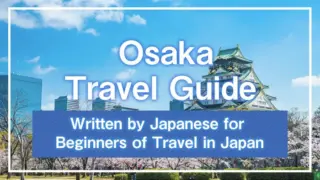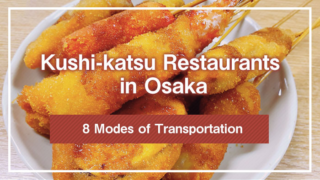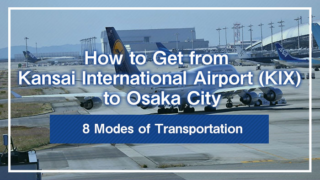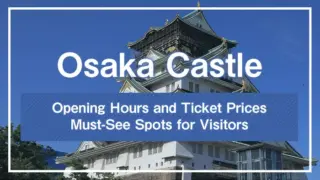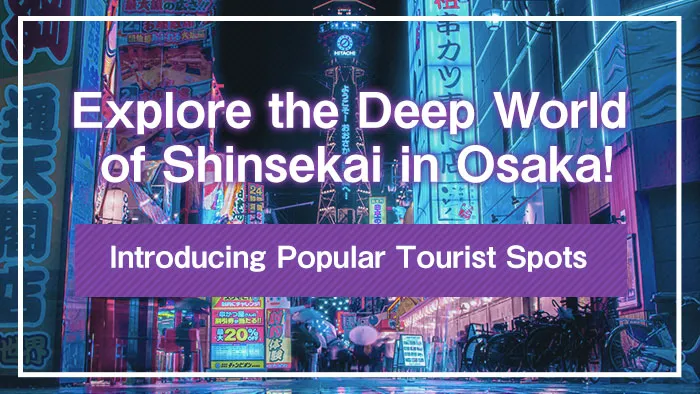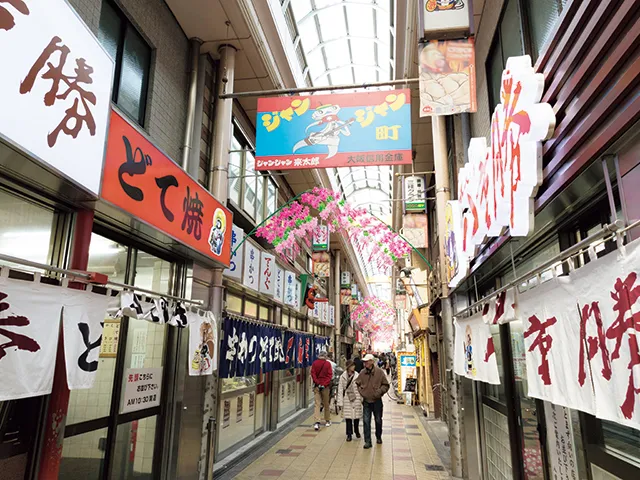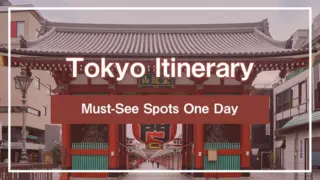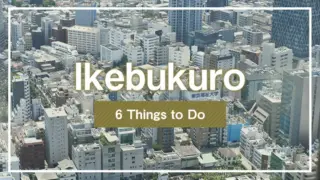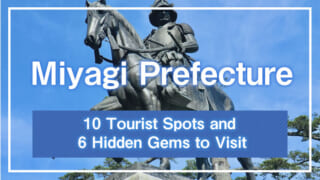Shinsekai, a fusion of flashy signs and the good old days of fun, is an ideal place to delve into the depth of Osaka culture. Reflecting the heart of Osaka, Shinsekai continues to captivate visitors with its retro shopping streets and unique atmosphere.
In this article, we introduce the multifaceted nature of Shinsekai in Osaka as a tourist destination, from its vibrant charm and historical landmarks like Tsutenkaku and the Billiken statue to spots where you can fully enjoy the deep culture of Osaka.
We also explain how to access Shinsekai, so please use this guide to fully enjoy this fascinating area when visiting Osaka.
1.Osaka and Shinsekai
Shinsekai is a retro shopping district centered around Tsutenkaku, located in Naniwa-ku, Osaka. Its unique charm lies in the flashy signs, vibrant neon lights, and the lively calls of shopkeepers, creating an atmosphere unlike any other. Shinsekai is also popular for its distinctive gourmet options and the opportunity to enjoy traditional Japanese games, making it a favorite tourist spot in Osaka.
Located just about 15 minutes by train from the heart of Osaka, such as Namba and Shinsaibashi, Shinsekai is a must-visit destination to add a little extra to your Osaka trip.
1-1.The History of Shinsekai
source:通天閣 [公式サイト]
The area around Shinsekai was once farmland and wasteland. It developed into an urban area with improved transportation networks after being selected as the site for the 5th National Industrial Exhibition (commonly known as the Expo) in 1903.
After the Expo, the eastern part of the site was transformed into Tennoji Park by the city of Osaka, while the western side (the current Shinsekai area) saw the construction of an amusement park called Luna Park. Within Luna Park, a tower modeled after the Eiffel Tower was built and named Tsutenkaku. With the opening of Luna Park and the construction of Tsutenkaku, the area around Shinsekai flourished as a major entertainment district, attracting theaters and eateries.
However, after Luna Park closed, theaters turned into pachinko parlors, and Shinsekai became a district overflowing with day laborers. The Tsutenkaku in the park was dismantled during World War II to prevent it from becoming a target for enemy forces, leading Shinsekai to lose its former liveliness.
In 1956, local residents, hoping for the revival of Shinsekai, constructed the current second-generation Tsutenkaku. Since then, the area has continued to develop as a beloved destination for both domestic and international tourists, while maintaining its traditional streetscape.
2.Explore the Deep World of Osaka’s Shinsekai
In Shinsekai, within a small area measuring 300 meters east to west and 600 meters north to south, various traditional shops line the streets, including Osaka’s famous kushikatsu (deep-fried skewered meat and vegetables) restaurants, pickle shops, Japanese confectionery stores, butcher shops, standing bars, and entertainment venues. The lively calls of shopkeepers intermingle in the Showa-era retro streetscape, creating a unique atmosphere not found in the central areas of Osaka.
2-1. Shinsekai’s Symbol: Tsutenkaku
The tower at the heart of Shinsekai is Tsutenkaku. Tsutenkaku is home to various facilities, but its main attraction is the observation deck.The “Golden Observation Deck” on the 5th floor is a particularly popular spot among tourists. The view of Osaka’s cityscape from this golden space is breathtaking.
In addition to the main observation deck, there is the “Observatory of Light” on the 4th floor and the special outdoor observation deck “Observation Paradise” on the rooftop. Observation Paradise is at a height of 94.5 meters, offering a panoramic view of the towering Abeno Harukas building as well. There’s also the thrilling “TIP THE TSUTENKAKU,” an overhanging observation platform that juts out about 5.4 meters from the side of Tsutenkaku, allowing visitors to enjoy a sensation of thrill and floating.
After enjoying the observation decks, head to the new attraction that was introduced in 2022, the “TOWER SLIDER.” This exciting slide has an incline of about 30 degrees, plunging from 22 meters above ground to the basement floor, offering a thrilling experience. It’s sure to become an unforgettable memory of your trip to Osaka.
2-2. Shinsekai’s Unique Icon: Billiken
source:通天閣 [公式サイト]
On the observation deck of the 5th floor of Tsutenkaku, there is a statue of a child with a pointed head and upturned eyes. This is “Billiken,” the icon of Shinsekai.
Billiken is a deity of happiness that originated from a dream seen by the American artist Florence Pretz. It is believed that rubbing the soles of its feet brings good fortune.When you find the Billiken statue, try rubbing the soles of its feet while making a wish.
In Shinsekai, the first Billiken statue was installed during the opening of Luna Park in 1912. This original statue went missing after the park closed, but in 1979, a new Billiken statue was placed on the observation deck of Tsutenkaku, becoming the official mascot of Tsutenkaku.
In 2014, to commemorate the 100th anniversary of Tsutenkaku and Shinsekai, the Billiken statue was replaced, making the current statue the third generation.
2-3.Asahi Theater: 110 Years of History
source:朝日劇場
Asahi Theater is a popular theater dedicated to traditional Japanese performance arts, located between Tsutenkaku and Tennoji Zoo.It opened as a cinema in 1910 and boasts a history of 110 years.It was renovated in 1977, transforming into the current theater dedicated to traditional Japanese popular drama.
Even just admiring the retro exterior can fully immerse you in the travel mood, but stepping inside reveals a genuine stage complete with box seats, a hanamichi (runway stage), and a revolving platform, sure to surprise you.
Different popular drama troupes perform each month, making it one of Japan’s premier theaters that continues to attract numerous fans today.Performances are held twice a day, at 12:00 PM and 5:30 PM, except on closed days.If the timing works out, it’s highly recommended to experience the unique Japanese theater available only here.
2-4.Shinsekai’s Deep Shopping Street: Janjan Yokocho
The Nanyo-dori Shopping Street, which stretches about 180 meters from Dobutsuen-mae Subway Station to Tsutenkaku, is known as “Janjan Yokocho.” The name originates from the post-war period when the sound of shamisen and drums played by shops to attract customers echoed “janjan” through the area.
In Janjan Yokocho, you can enjoy a variety of quick, affordable, and delicious options, including Osaka’s famous kushikatsu (deep-fried skewers), as well as yakiniku (grilled meat), udon, sushi, and standing bars, making it a great place for food enthusiasts to explore and enjoy eating their way through.
source:大阪観光コンシェルジュ
Beyond gourmet delights, Janjan Yokocho offers entertainment spots where you can enjoy shooting galleries, ring tossing, and smart ball games. It’s also worth taking a peek into the Go and Shogi (Japanese chess) clubs, where you can experience the deep connections between people.
For couples touring the area, engaging with attractions like “Lovers’ Truth,” modeled after Rome’s “Mouth of Truth,” or “Love’s Key,” where couples can pledge their eternal love, can add excitement to their visit.
2-5. Experience Japanese Onsen Culture at Spa World
Just a 3-minute walk from Shinsekai, “Spa World: Onsen from Around the World” is a facility where you can enjoy Japanese onsen culture while feeling as if you’re traveling the world.
The onsen facilities are divided into two zones: the European Zone on the 4th floor and the Asian Zone on the 6th floor.
In the European Zone on the 4th floor, you can enjoy a variety of seven baths, including an ancient Roman-style bath, a herb bath with statues of goddesses, and a bath that replicates Italy’s Blue Grotto.
On the 6th floor’s Asian Zone, there are baths unique to Japan, such as a stream open-air bath and a large hinoki (Japanese cypress) bath. A delightful point is being able to experience Japanese-style baths without having to travel to a hot spring resort. Additionally, there are baths inspired by Bali, Singapore, Islam, and Persia, allowing you to easily enjoy the ambiance of traveling through Asia.
In addition to the onsen facilities, Spa World also features a heated pool area that can be enjoyed year-round, a food court, relaxation facilities, and accommodations.After bathing, you can relax and unwind, healing the fatigue from touring Shinsekai.
3.Access to Osaka’s Shinsekai
To get to Shinsekai, you can walk from the nearest train stations. The closest stations in order are “Ebisucho Station,” “Dobutsuen-mae Station,” and “Shin-Imamiya Station.”
- From Osaka Metro Sakaisuji Line’s “Ebisucho Station”
- From Osaka Metro Midosuji Line & Sakaisuji Line’s “Dobutsuen-mae Station”
- From JR “Shin-Imamiya Station”
Here’s how to access Shinsekai from each station:
1. From Osaka Metro Sakaisuji Line’s “Ebisucho Station”
Exiting from Exit 3, you’ll find yourself right in front of Tsutenkaku Tower. For those who want to get there without any confusion, using Ebisucho Station is recommended.
2. From Osaka Metro Midosuji Line & Sakaisuji Line’s “Dobutsuen-mae Station”
Exit 5 is the closest to Shinsekai. After coming out of Exit 5, go straight ahead with the street marked Maruhan on your left, and Tsutenkaku Tower will appear on your right. Continue further, and you’ll see a gate marked “SHINSEKAI.”
3. From JR “Shin-Imamiya Station”
The Tsutenkaku exit (East exit) is the nearest exit to Shinsekai. The East exit is virtually in the same location as the Dobutsuen-mae Station’s Exit 5, so you’ll follow the same route to Shinsekai as mentioned in point 2.
Conclusion
Shinsekai, located in Naniwa Ward, Osaka City, is known as a retro shopping district and is a vibrant tourist destination with a unique atmosphere centered around Tsutenkaku Tower.
It developed following the Domestic Exposition in 1903 and has now become popular as a spot where visitors can enjoy traditional games and unique gourmet food. In particular, the view of Osaka’s cityscape from the observatory of Tsutenkaku Tower, the Billiken statue, and historic buildings like the Asahi Theater are among its highlights. Additionally, Shinsekai is packed with places where you can experience the deep culture of Osaka, such as Janjan Yokocho alley and Spa World.
Access to Shinsekai is easy on foot from Ebisucho Station, Dobutsuen-mae Station, and Shin-Imamiya Station, making it conveniently close to the center of Osaka. Shinsekai is definitely a spot you’ll want to visit when traveling to Osaka.
*This article is based on information available as of March 2024.

